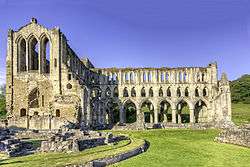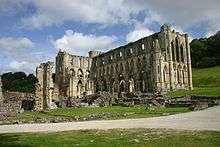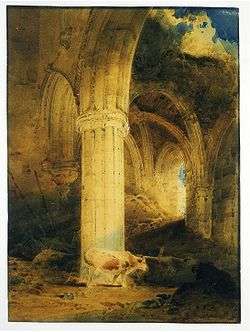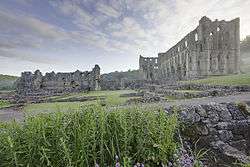Rievaulx Abbey
 | |
 Location within North Yorkshire | |
| Monastery information | |
|---|---|
| Order | Cistercian |
| Established | 1132 |
| Disestablished | 1538 |
| Mother house | Clairvaux Abbey |
| Diocese | Diocese of York |
| People | |
| Founder(s) | Walter l'Espec and Thurstan, Archbishop of York |
| Important associated figures | Ailred of Rievaulx |
| Site | |
| Location | Rievaulx, North Yorkshire, England |
| Coordinates | 54°15′27″N 1°7′0″W / 54.25750°N 1.11667°WCoordinates: 54°15′27″N 1°7′0″W / 54.25750°N 1.11667°W |
| Visible remains | substantial |
| Public access | yes |
Rievaulx Abbey /riːˈvoʊ/ ree-VOH was a Cistercian abbey in Rievaulx, situated near Helmsley in the North York Moors National Park, North Yorkshire, England. It was one of the great abbeys in England until it was seized under Henry VIII of England in 1538 during the dissolution of the monasteries. The striking ruins of its main buildings are a tourist attraction, owned and maintained by English Heritage.
Foundation
Rievaulx Abbey was the first Cistercian monastery in the north of England, founded in 1132 by twelve monks from Clairvaux Abbey.
Its remote location was well suited to the order's ideal of a strict life of prayer and self-sufficiency with little contact with the outside world. The abbey's patron, Walter Espec, also founded another Cistercian community, that of Wardon Abbey in Bedfordshire, on unprofitable wasteland on one of his inherited estates.
The first abbot of Rievaulx, St William I, started construction in the 1130s. The second abbot, Saint Aelred of Rievaulx, elected in 1147, expanded the buildings and otherwise consolidated the existence of what with time became one of the great Cistercian abbeys of Yorkshire, second only to Fountains Abbey in fame. Under Aelred, the abbey is said to have grown to some 140 monks and 500 lay brothers.[1] By the end of his tenure, Rievaulx had five daughter-houses in England and Scotland.[2]
Financial prosperity
The abbey lies in a wooded dale by the River Rye, sheltered by hills. The monks diverted part of the river several yards to the west in order to have enough flat land to build on. They altered the river's course twice more during the 12th century. The old course is visible in the abbey's grounds. This is an illustration of the technical ingenuity of the monks, who over time built up a profitable business mining lead and iron, rearing sheep and selling wool to buyers from all over Europe. Rievaulx Abbey became one of the greatest and wealthiest in England, with 140 monks and many more lay brothers. It received grants of land totalling 6,000 acres (24 km²) and established daughter houses in England and Scotland.
By the end of the 13th century the abbey had incurred debts on its building projects and lost revenue due to an epidemic of sheep scab (psoroptic mange). The ill fortune was compounded by raiders from Scotland in the early 14th century. The great reduction in population caused by the Black Death in the mid-14th century made it difficult to recruit new lay brothers for manual labour. As a result, the abbey was forced to lease much of its land. By 1381 there were only fourteen choir monks, three lay brothers and the abbot left at Rievaulx, and some buildings were reduced in size.
By the 15th century the Cistercian practices of strict observance according to Saint Benedict's rule had been abandoned in favour of a more comfortable lifestyle. The monks were permitted to eat meat, and more private living accommodation was created for them, and the abbot had a substantial private household in what had once been the infirmary.
Dissolution
At the time of its dissolution in 1538, the abbey was said to consist of 72 buildings occupied by the abbot and 21 monks, with 102 lay employees, and an income of £351 a year. The abbey owned a prototype blast furnace at Laskill, producing cast iron as efficiently as a modern blast furnace.
As was standard procedure, the confiscated monastic buildings were rendered uninhabitable and stripped of valuables such as lead. The site was granted to the Earl of Rutland, one of Henry's advisers, until it passed to the Duncombe family.
In the 1750s Thomas Duncombe III beautified his estate by building the terrace with two Grecian-style temples. They are in the care of the National Trust. The abbey ruins are in the care of English Heritage.
When awarded a life peerage in 1983, former prime minister Harold Wilson, a Yorkshireman, adopted the title "Baron Wilson of Rievaulx".
Burials
Gallery
 Rievaulx Abbey
Rievaulx Abbey Rievaulx Abbey viewed from Rievaulx Terrace (NT)
Rievaulx Abbey viewed from Rievaulx Terrace (NT) Rievaulx Abbey
Rievaulx Abbey Ruins of Rievaulx Abbey, 1803, by John Sell Cotman
Ruins of Rievaulx Abbey, 1803, by John Sell Cotman Rievaulx Abbey showing Presbytery (R), South Transept, Chapter House foundations & wall of Infirmary (L)
Rievaulx Abbey showing Presbytery (R), South Transept, Chapter House foundations & wall of Infirmary (L)
See also
References
- Caroe and Partners (2001). A Second Paradise of Wooded Delight: Rievaulx Abbey Conservation Plan Volume 2. English Heritage.
- Fergusson, Peter; Harrison, Stuart (2000). Rievaulx Abbey. Community, Architecture, Memory. Yale University Press.
- Woods, Thomas (2005). How the Catholic Church Built Western Civilization. ISBN 0-89526-038-7.
- Derbyshire, David (21 June 2002). "Henry 'Stamped Out Industrial Revolution'". The Daily Telegraph. Retrieved 30 June 2014.
- Specific
- ↑ Walteri Danielis Vita Ailredi Abbatis Rievall, ed. FM Powicke, (London, 1959), ca. 30.
- ↑ cf. Walter Daniel records a visitation that Aelred made to Dundrennan. Aelred Squire, OP, Aelred of Rievaulx: A Study (London: SPCK, 1969), p. 65
External links
| Wikimedia Commons has media related to Rievaulx Abbey. |